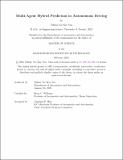Multi-Agent Hybrid Prediction in Autonomous Driving
Author(s)
Yau, Tiffany Yee Kay
DownloadThesis PDF (3.319Mb)
Advisor
Williams, Brian C.
Terms of use
Metadata
Show full item recordAbstract
In autonomous driving, the hybrid task of predicting both high-level actions and lowlevel trajectories of human behaviour is fundamental to safe downstream decision-making. Much of the existing work in behaviour prediction tackle this problem without sufficiently modelling agent-agent interactions, limiting their ability to capture the full range of possible joint outcomes. Another key challenge in multi-agent prediction is the intractable prediction space that grows exponentially in the number of agents and duration of the prediction horizon. As a result, scalability is a major challenge. This thesis presents two approaches to address these challenges in multi-agent hybrid prediction. In our first approach, we model interactions and address scalability by learning to factor the joint prediction distribution. We observe that agents do not interact with all other agents in the scene, but rather, there are groups that strongly interact. Therefore, we group agents and represent the high-level interaction outcomes of groups with discrete variables. We additionally assume that inter-group interactions are sparse and can be sufficiently represented with a directed acyclic graph. These assumptions enable us to factor the distribution into a product of factors, effectively reducing the prediction space, and providing an order in which to easily sample discrete values. We evaluate the performance of this method on a large-scale autonomous driving dataset and show that it exceeds prior methods in coverage of possible interaction outcomes by 24% to 48% on various multi-agent validation data splits, while maintaining state-of-the-art prediction error. Our second approach represents agents in a traffic scene as a set of concurrent hybrid models and assumes a collision avoidance model of interactions, rather than learning the model from data like the first approach. Our method begins enumeration based on a simpler collision-agnostic prior distribution. Based on our factored representation, we determine the next best assignment to the prior. We extract bounding conflicts to correct the prior and increasingly reduce the error between the distribution used by enumeration and our collision-aware posterior distribution. Our experiments show that enumeration using A* with bounding conflicts (A*BC) is faster than A* and is therefore better at addressing scalability. In terms of prediction metrics, we find that our collision-aware posterior performs worse than the collision-agnostic prior and suggest future directions for improvement.
Date issued
2025-02Department
Massachusetts Institute of Technology. Department of Aeronautics and AstronauticsPublisher
Massachusetts Institute of Technology